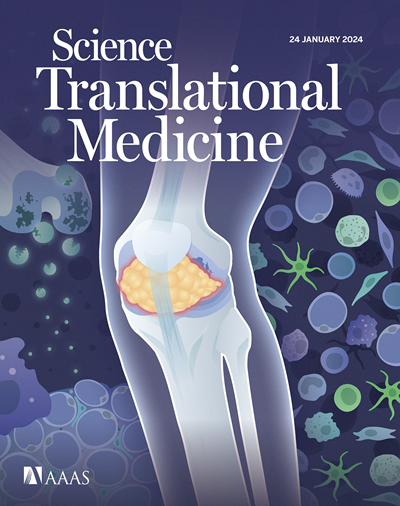利用click化学对大鼠和非人灵长类动物大脑反义寡核苷酸分布进行PET成像
IF 15.8
1区 医学
Q1 CELL BIOLOGY
引用次数: 0
摘要
确定药物的生物分布对于确保药物到达目标组织至关重要。这在大脑中尤其具有挑战性,因为侵入性采样方法可能是不可能的。在这里,我们提出了一种预靶向正电子发射断层扫描(PET)成像方法,该方法使用生物正交点击化学来确定鞘内给药后反义寡核苷酸(ASO)在大鼠和非人灵长类动物大脑中的分布。一种PET示踪剂,[18 F]BIO-687,带有点击反应性反式环烯,并与甲基四氮基偶联的测试Malat1 ASO一起开发和测试。大鼠PET显像结果表明,该示踪剂在啮齿类动物中枢神经系统中具有良好的PET显像动力学性能,并能在体内与甲基四嗪偶联的ASO反应形成高特异性的共价键。此外,通过比较组织匀浆中的PET成像信号和液相色谱-质谱信号,确定了通过环加成与甲基四嗪反应的PET示踪剂的量取决于大鼠脑组织中aso -甲基四嗪的浓度。该方法在食蟹猕猴中使用Malat1测试ASO和靶向微管相关蛋白tau (MAPT)基因的候选治疗性ASO BIIB080进行了评估。PET成像显示出良好的示踪动力学和特异性结合在非人灵长类动物(NHP)的大脑。这些结果表明PET显像示踪剂[18 F]BIO-687可以显示鞘内递送的ASOs在大鼠和NHP脑内的分布。本文章由计算机程序翻译,如有差异,请以英文原文为准。
PET imaging of antisense oligonucleotide distribution in rat and nonhuman primate brains using click chemistry
Determination of a drug’s biodistribution is critical to ensure that it reaches the target tissue of interest. This is particularly challenging in the brain, where invasive sampling methods may not be possible. Here, we present a pretargeted positron emission tomography (PET) imaging methodology that uses bioorthogonal click chemistry to determine the distribution of an antisense oligonucleotide (ASO) in the brains of rats and nonhuman primates after intrathecal dosing of ASO. A PET tracer, [18F]BIO-687, bearing a click-reactive trans-cyclooctene was developed and tested in conjunction with a test Malat1 ASO conjugated with a methyltetrazine group. PET imaging in rats demonstrated that the tracer had good kinetic properties for PET imaging in the rodent central nervous system and could react to form a covalent linkage with high specificity to the methyltetrazine-conjugated ASO in vivo. Furthermore, the amount of PET tracer reacted by cycloaddition with the methyltetrazine was determined to be dependent on the concentration of ASO-methyltetrazine in rat brain tissue, as determined by comparing the PET imaging signal with the liquid chromatography–mass spectrometry signal in the tissue homogenates. The approach was evaluated in cynomolgus macaques using both the Malat1 test ASO and a candidate therapeutic ASO, BIIB080, targeting the microtubule-associated protein tau (MAPT) gene. PET imaging showed favorable tracer kinetics and specific binding to both ASOs in nonhuman primate (NHP) brain in vivo. These results suggest that the PET imaging tracer [18F]BIO-687 could show the distribution of intrathecally delivered ASOs in the rat and NHP brains.
求助全文
通过发布文献求助,成功后即可免费获取论文全文。
去求助
来源期刊

Science Translational Medicine
CELL BIOLOGY-MEDICINE, RESEARCH & EXPERIMENTAL
CiteScore
26.70
自引率
1.20%
发文量
309
审稿时长
1.7 months
期刊介绍:
Science Translational Medicine is an online journal that focuses on publishing research at the intersection of science, engineering, and medicine. The goal of the journal is to promote human health by providing a platform for researchers from various disciplines to communicate their latest advancements in biomedical, translational, and clinical research.
The journal aims to address the slow translation of scientific knowledge into effective treatments and health measures. It publishes articles that fill the knowledge gaps between preclinical research and medical applications, with a focus on accelerating the translation of knowledge into new ways of preventing, diagnosing, and treating human diseases.
The scope of Science Translational Medicine includes various areas such as cardiovascular disease, immunology/vaccines, metabolism/diabetes/obesity, neuroscience/neurology/psychiatry, cancer, infectious diseases, policy, behavior, bioengineering, chemical genomics/drug discovery, imaging, applied physical sciences, medical nanotechnology, drug delivery, biomarkers, gene therapy/regenerative medicine, toxicology and pharmacokinetics, data mining, cell culture, animal and human studies, medical informatics, and other interdisciplinary approaches to medicine.
The target audience of the journal includes researchers and management in academia, government, and the biotechnology and pharmaceutical industries. It is also relevant to physician scientists, regulators, policy makers, investors, business developers, and funding agencies.
 求助内容:
求助内容: 应助结果提醒方式:
应助结果提醒方式:


